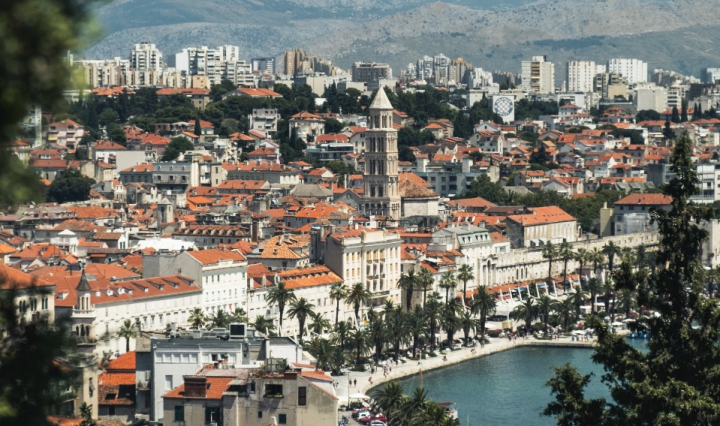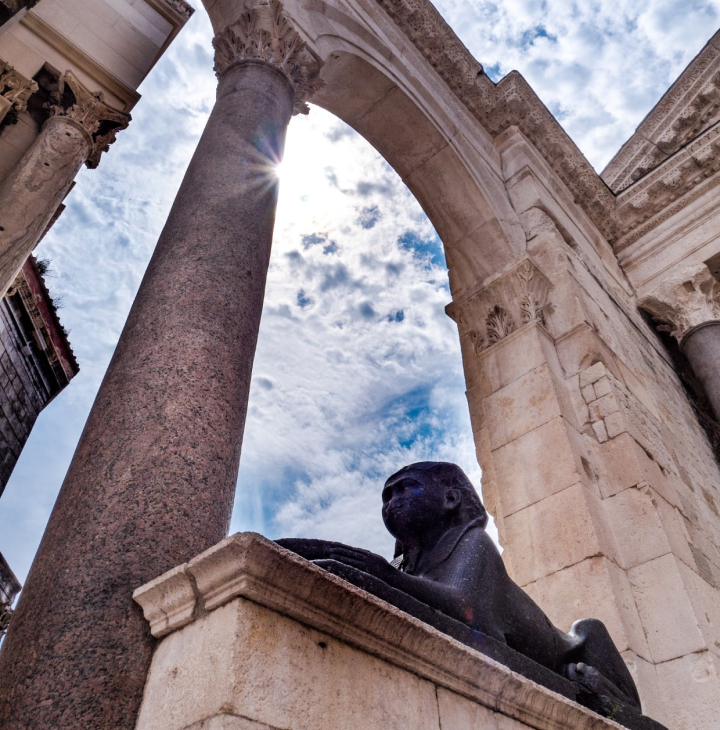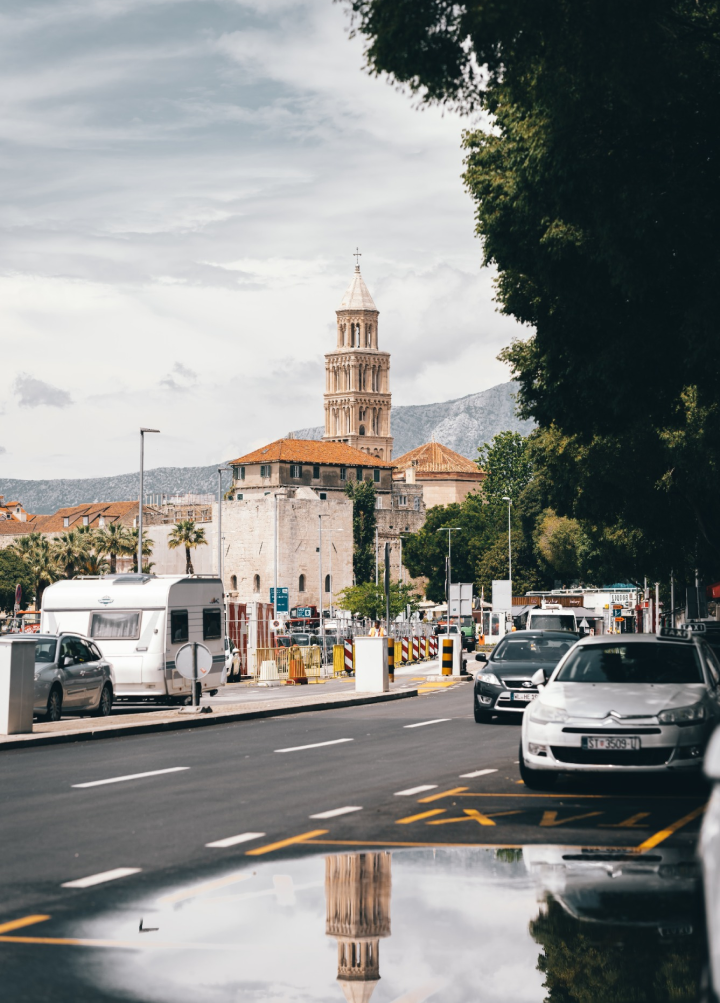
Split, Croatia
About Split Croatia
A few general facts about Split Croatia – the town is the second-largest city in the country and the largest city in the Dalmatia region. The city was originally built around the Diocletian’s Palace (a fortress-like palace built for the retired Roman emperor Diocletian), where the locals sought refuge many centuries ago. However, despite its initial appearance, the city is not a small tourist town. It extends over a large area, well beyond the ancient city center. Modern Split is a city with 180 000 inhabitants. It represents the economic hub of the Eastern Adriatic shoreline (an unofficial “capital” of Dalmatia).

Split Attractions

Poljud stadium – Poljud stadium, better known as “Poljudska Ljepotica” (“Poljud Beauty”) is the second-largest stadium in Croatia with a capacity of 36,000 people. The stadium was originally constructed by the Yugoslavian government as part of the facilities for 1979. Mediterranean Games. It was officially opened by Josip Broz Tito, who was a great fan of the team. The team played their home games in Poljud HNK Hajduk Split. By far, the most important and revered sports team in Dalmatia, dedicated fans around the world have followed Hajduk throughout the team’s history. There are numerous anecdotes that Hajduk never played without at least some of their loyal fans in the stands, the Torcida. It is the oldest supporters group in Europe. If you plan to go to some match, avoid the Northern part, which is the cheapest one because that part is reserved for Torcida.
Getski vrtal – is the smallest park in Split Croatia, situated in the Diocletian’s palace (THE ONLY GREEN AREA INSIDE THE CITY WALLS), on Dominisova Street (Marko Antonio De Dominis Street). In the park, there are beautiful traditional Dalmatian “tiramolas” (that is a way how the locals dry their clothes). During summer, they are full of clothes drying in the sunshine. You will find pictures from the Getski vrtal in every Split guidebook. It is the location of a 500-year-old stone house, that was destroyed during World War II. On the facade facing towards Getski vrtal, you can see two heads made of stones. One belongs to a sphinx and it has a Christian cross on its forehead and the second one is a head of Middle Age thief. Getski (from ghetto) vrtal (garden) is made and maintained by the locals, who live in nearby houses.
Marjan – a hill situated on the West of the Split. Marjan is an oasis for many people, who look for natural stress relief. It is a great place for long walks, jogging, and bike rides. Marjan’s peak, Telegrin is 174 m high and provides a wonderful panoramic view of Split Croatia. Its Southern cliffs are popular for alpine climbers. St. Nicholas Church is situated on the Eastern side of Marjan, and along the Southern rim is the beautiful church of St. Jerome and “Gospa od Betlema” Church (“Madonna of Bethlehem”). House building is strictly forbidden for the preservation of Marjan – the lungs of Split.
Split Travel Info
By plane – The nearest international and local airport is Split. Split’s airport is approximately 25 km to the Northwest of the town between Kastela and Trogir. Croatia Airlines buses (ticket price is 30 kn one way or 40 kn daily ticket in both ways) connect the city with scheduled flights, dropping passengers on the waterfront Riva, near the Croatia Airlines office; alternatively, the #37 Trogir-Split bus (ticket price is 13.50kn) goes from the airport to the suburban bus station – “Domovinskog rata”, twenty minutes to the North of the city center. A taxi from the airport costs between 200 kn and 300 kn.
By train – Croatia is directly connected to Slovenia, Bosnia and Herzegovina, Hungary, Italy, Austria, Switzerland, Germany, Serbia and Montenegro and with almost every other European country. Regular lines from numerous European cities lead to Split via Zagreb. The train station is five minutes walk away to the Southeast of the city center on the main harbor front road, Obala kneza Domagoja. All the ferry and hydrofoil berths are situated on the same street. There are two daily trains to Zagreb, that stop at Knin and Karlovac on the way (2 per day, 6.5 hours; 1 direct night train, 9 hours); in Zagreb, you can transfer to Ljubljana (4 per day, 9 hours total).
By ferry/ boat – Split is Dalmatian coast Jadrolinija main terminal, with regular local ferries rides to the islands of Brac, Vis, Lastovo, Hvar and Korcula; it’s also a major stop in the summer coastal ferry service, which connects Split with Rijeka, Rab, Zadar and Dubrovnik. In summer, the coastal ferry goes to Bari, Italy (1-2 weekly) and Igoumenitsa, Greece (1 weekly), while from June to September there are almost every day ferry rides to Ancona, Italy. For the main coastal ferry, pre-booking is recommended.
By bus – All mentioned routes are provided by multiple companies, that charge slightly differently. Always ask about the fastest option in order to save time. It’s smart to arrive about 30 minutes before departure and buy tickets (better yet, during peak season, it is recommended to buy them earlier in the day). Ask English-speaking staff at Split’s bus station for handy little schedules of popular journeys.
By car – Split is well connected with the rest of Croatia by recently built highways and you can reach it easily and fast once you reach the highway. To come from Zagreb to Split (by A-1 super expressway) you will need to drive approximately 380 km for 3h and pay the toll of 20 to 25 euro. There could be traffic delays during the summer season on the Croatian border. Laws regulating traffic in Croatia are similar to those in the majority of European countries. You can also reach Split by driving on Adriatic Coastal Road free of charge, but you will drive slowly and it could take you about 5 hours to reach Split Croatia.
